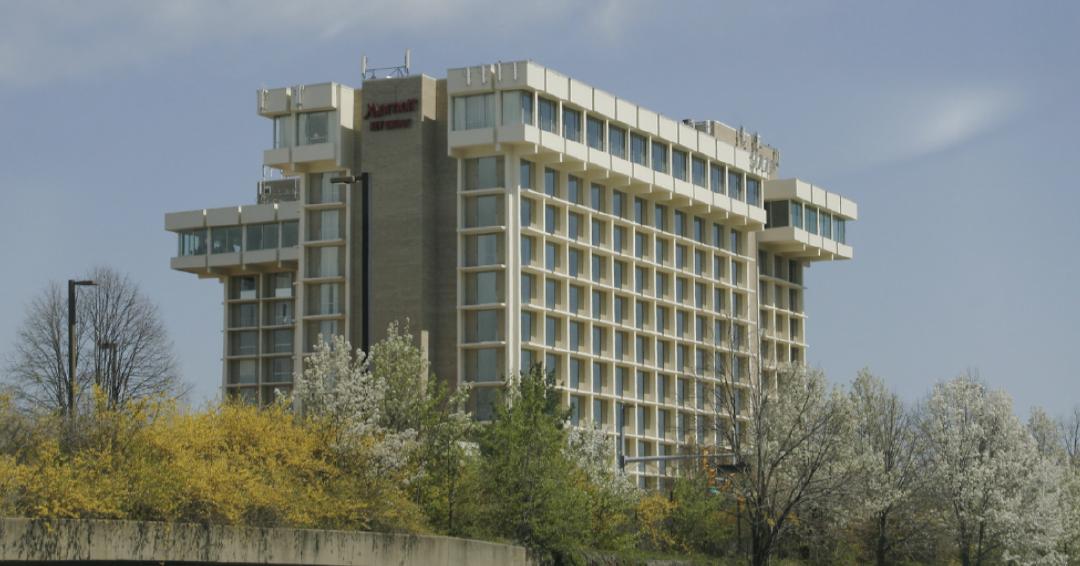The Key Bridge Marriott Hotel

The 12-story hotel with almost 600 rooms has remained unoccupied since July 2021. Nevertheless, it still stands in its prominent position, overlooking Georgetown and the Potomac River, at the southern base of the Francis Scott Key Bridge in Washington, D.C.
The Key Bridge Marriott Hotel, an iconic fixture of Arlington's Rosslyn district, was the second hotel built by the global hotelier in 1959. It was the company's oldest hotel until it closed in July 2020 due to the COVID-19 pandemic, which caused a drastic reduction in room occupancy rates.
The 12-story hotel with almost 600 rooms has remained unoccupied since July 2021. Nevertheless, it still stands in its prominent position, overlooking Georgetown and the Potomac River, at the southern base of the Francis Scott Key Bridge in Washington, D.C. KBLH LLC, a subsidiary of Woodridge Capital Partners, purchased the building, which has been approved for demolition. The hotel is to be replaced by two new residential buildings.
The Key Bridge Marriott has been a landmark on the Virginia side of the Key Bridge for more than 60 years. It sits above the George Washington Parkway, overlooking the Arlington Palisades in Virginia. The hotel was constructed on the site of a "Hot Shoppes" diner/restaurant owned by Marriott and had been operating there since 1940. The diner was located on the south end of the Francis Scott Key Bridge, which connects Arlington, VA, to Washington D.C. Marriott's first venture into the hotel industry was the Twin Bridges Marriott, built in 1957 just a few miles south of Rosslyn on the Potomac River in Crystal City, VA. Unfortunately, it was demolished in 1988.
The hotel initially opened as a “motor lodge” catering to tourists and visitors. It provided easy access via the immediately adjacent Key Bridge to Georgetown and the C&O Canal Parkway out of town. Its location at the eastern terminus of what was to become I-66, a major route to and from Washington, made it accessible and popular for travelers, tourists, vacationers, and businessmen.
The original construction was a low-rise, three and four-story grouping of three buildings in a U-shape around a swimming pool and plaza. The Hot Shoppes remained. Subsequently, the present 12-story building was constructed on the site, necessitating the demolition of the Hot Shoppes restaurant.
The Key Bridge Marriott Hotel was dedicated in July 1959. Actress Dina Merrill and Debbie Marriott, granddaughter of company founder and owner J.W. Marriott, cut the ribbon. (Ms. Marriott later worked at the hotel's reception desk as a part-time substitute during summer break from college.)
[The hotel parking lot was the site of the transfer of $350,000 in cash by White House aide Alexander Butterfield in 1972. At the time, Butterfield was the second most powerful person on the White House staff, where he worked as a deputy to then White House Chief of Staff H.R. “Bob” Haldeman, who reported directly to President Richard M. Nixon. As Nixon’s re-election in 1972 approached, his campaign team began collecting large sums of money, much of it cash. Some of this cash was used for illegal purposes connected with the Watergate scandal, such as surveillance and paying for the burglary. Haldeman kept $350,000 cash in a locked
briefcase in the office of Hugh Sloan, Jr., who put it in a vault at the Headquarters of the Committee to Re-elect the President (CREEP) in Washington, D.C. Haldeman often referred to the stash of cash as “the 350.” Haldeman aide Gordon C. Strachan moved the money to the White House in April 1972, but Haldeman ordered it removed. Strachan then asked Butterfield to handle the cash by giving it to someone Butterfield trusted.
Butterfield removed the cash and, on April 7, 1972, met a close friend named Leonard Lilly in the Key Bridge Marriott parking lot. Lilly agreed to keep the money in a safe deposit box in Arlington and make it available to the White House on demand. Butterfield voluntarily revealed his role in "the 350" to the United States Attorney shortly after leaving the White House in March 1973. Washington Post reporter Bob Woodward later met with “Deep Throat” (since revealed as Mark Felt) in a garage about a block away to the south across I-66 and Lee Highway (Langston Blvd.).
The hotel’s casual restaurant, “Allie’s American Grille,” has featured a “Top Secret” menu on occasion. Items on the menu include “Presidential Meatloaf” for $12.95 (2009 prices), a favorite of her husband, the President, from Pat Nixon's recipe. It was served with mashed potatoes and vegetables. This meatloaf recipe was once so popular it was reprinted on White House stationery for mailing upon request. The hotel’s executive chef has stated that he has “taken great care to ensure we are following the recipe precisely as Mrs. Nixon intended.
Images




